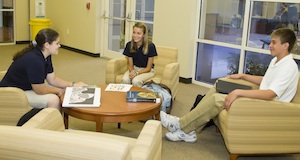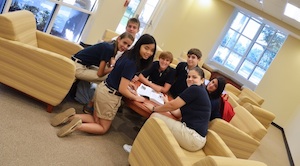Library Technology | Feature
iCommons: The Library Evolved
This is the first in a three-part series focused on the changing role of the K-12 library. Each article in the series will look at a how schools are reinterpreting the role of the library and what's being done to reposition it to remain relevant and fresh in the digital age.
- By Bridget McCrea
- 10/05/11
It's not unusual for prospective students and their parents to walk into the Oxbridge Academy of the Palm Beaches' library and do a double take as soon as they cross the threshold into the building. After all there are no physical books in the building, and certain aspects of the space mimic what you'd find in your typical Barnes & Noble cafe. Not exactly what you'd expect from your typical high school library.
"Most people are accustomed to walking into a library and seeing shelves that are jammed full of books," said Mark Bodnar, CIO and director of information technology for the West Palm Beach, FL institution. "When you take a library digital, however, you no longer have cavernous rooms with endless rows of books for everyone look at. That can be disconcerting for some people."


Oxbridge Academy students in the "cafe" side of the iCommons library |
Electronic Books, Cafe Atmosphere
Newly opened for the 2011-2012 school year, Oxbridge Academy welcomed its first class of ninth- and 10th-grade students this last August. Instead of a traditional library, the school decided to create "iCommons" to serve as a center of intellectual activity and academic life. Along with various electronic databases from which students can access millions of articles from journals and magazines, iCommons' central library of 100,000 books is accessible to students and teachers online in full-text.
The physical space is a lot different from what you'd normally find in a library. On the cafe side there are large, overstuffed armchairs and long tables meant to encourage collaboration between students. Group study rooms filled with iMacs and large, flat-screen panel monitors entice students to work together on audiovisual projects. The building also includes a media lab and separate areas for students who want to work individually.
"The idea is that the atmosphere moves from louder to quieter as you progress through the rooms," said Carolyn Kost, director of information resources. "This is not a 'shushing' library. Students can do silent work but this is primarily a collaborative workspace."
To design iCommons the team at Oxbridge Academy examined current trends taking place at college and secondary campuses nationally. What it discovered was that more and more of those institutions were forgoing traditional setups in favor of libraries centered on electronic collections.
"Students want to be able to hang out with their laptops and have access to different resources," said Kost, who has been a secondary school librarian for 26 years. During that time Kost said her role has shifted from helping students gather scarce resources to helping them select from abundant resources and craft their own narratives. That requires both media and information literacy training, said Kost, and an ability on the part of the student to evaluate the resources and extrapolate the most relevant information.
iCommons Technologies
When deciding on iCommons' collection, Kost and Bodnar said they wanted the majority of the texts to be available online. To fulfill that need the school subscribed to several online libraries, the largest of which, Questia, has 100,000 full-text books available on the Web. An unlimited number of students can use the resource simultaneously, said Kost, "so there's never the problem of a book being checked out and unavailable."
Questia also allows students to create their own "virtual bookshelves," highlight and bookmark text, make up note cards, and format bibliographies. Equipped with their own Macbook Pros, students can access the collection from anywhere on a 24/7 basis. Bodnar said the computer-collection setup solves many of the issues that high schools are dealing with right now. Budgets are tight, and books quickly become obsolete.
"I don't see why any school wouldn't choose the digital route given the cost of books and the impact that they have on our environment," said Bodnar. Kost concurred and said that science books are particularly onerous. "These books are already obsolete by the time they are published," she lamented. "By going digital we're able to give our students the most recent, relevant information all the time."
iCommons' catalog also links directly to Google Books. A service that searches the full text of books that have been scanned by Google, this allows students and teachers to view titles, pages, tables of contents, and user ratings before searching for the materials in iCommons' digital collection.
Oxbridge Academy's High-Tech Tools
CIO Mark Bodnar said his school's goal is not simply to be "wired" but to use technology in a way that is compelling, exciting, and ever-evolving. In addition to iCommons the school is using these high-tech tools to achieve that goal: - Multi-touch interactive whiteboards that allow up to four students at a time to collaborate on a single board;
- Instructure Canvas open learning management system (LMS) that allows teachers to upload video, audio, and documents for sharing online;
- AV equipment and projectors;
- A complete 1:1 Macbook Pro initiative with charging stations on campus; and
- Site licenses for Adobe, Microsoft, and Apple software.
|
Supporting Students, Convincing Parents
To manage iCommons, Oxbridge Academy uses a blended approach that includes both its IT department and its library staff. Together they supervise iCommons' physical space, digital collections, and its helpdesk. The latter is staffed and open to students at the beginning and the end of every school day. Bodnar said the blended setup has worked out well so far.
"It's a huge team effort that finds our IT team and library staff constantly working together," said Bodnar.
Part of that effort also includes parent training. "For parents of a certain age, it can be difficult to understand why there are no books in our library," said Bodnar. "We're working through that issue with good information and education on the value of being able to digitally access a book whenever you want it."
Kost said iCommons' first months have gone smoothly. As a librarian she said she's most impressed with the way in which students have embraced the collaborative environment that her team worked so hard to set up and promote. "There are just so many opportunities for production, creativity, and collaboration in this environment," said Kost. "Being able to watch it unfold before our eyes--and in this digital environment--is pretty magical."
The Library Evolved
This article is one part of a three-part series. Use the links below to locate other articles in this series. Note: Part 3 has not yet been published.
Part 1: iCommons: The Library Evolved, a look at the "iCommons" at the Oxbridge Academy of the Palm Beaches
Part 2: The All-Digital Library, an exploration of Cushing Academy's Fisher-Watkins Library.
Part 3: Coming in November! |